TIMOTHY LEE "TIM" RICHMOND - 06/07/1955 - 08/13/1989
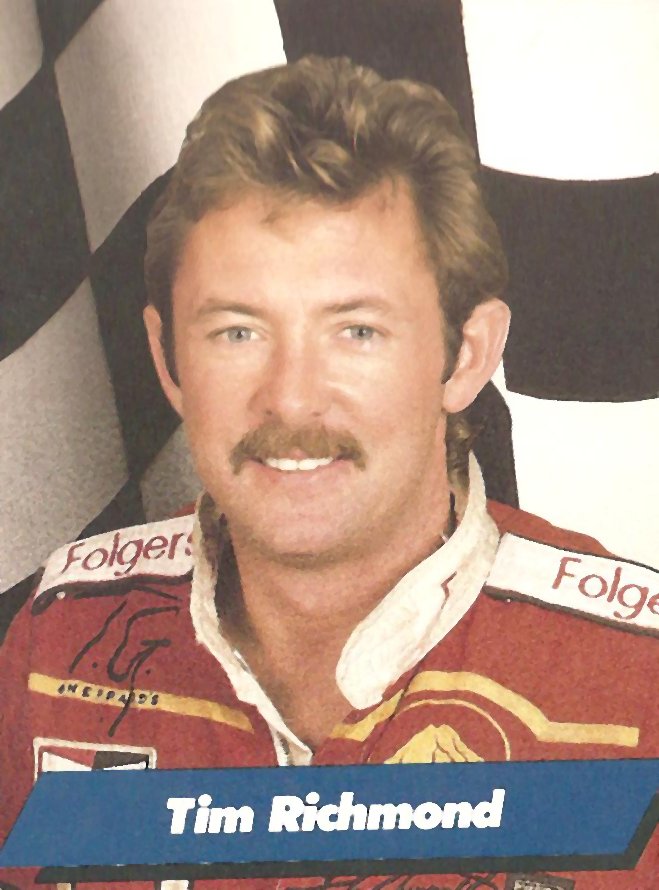
was an American race car driver from Ashland, Ohio. He competed in Indy Car racing before transferring to NASCAR's Cup Series. He won the 1980 Indianapolis 500 Rookie of the Year award and had 13 victories during eight NASCAR seasons. Richmond achieved his top NASCAR season in 1986 winning seven races, and he finished third in points. He won seven races that season, more than any other driver on the tour. When he missed the season-opening Daytona 500 in February 1987, media reported that he had pneumonia. The infection most likely resulted from his compromised immune system, which was weakened by AIDS. The disease drastically shortened his life. (complete story below) Despite the state of his health, Richmond competed in eight races in 1987, winning two events and one pole position before his final race in August of that year. He attempted a comeback in 1988 before NASCAR banned him for testing positive for a banned substance; after NASCAR insisted on access to his entire medical record before reinstating him, Richmond withdrew from racing. NASCAR later stated their original test was inaccurate. Charlotte Motor Speedway president Humpy Wheeler said: "We've never had a race driver like Tim in stock car racing. He was almost a James Dean-like character. When Richmond was cast for a bit part in the 1983 movie Stroker Ace. "He fell right in with the group working on the film," said director Hal Needham. Cole Trickle,
the main character in the movie Days of Thunder, played by Tom Cruise, was loosely based on Richmond and his interaction with Harry Hyde and Rick Hendrick. Tim's driving days started as a toddler when he was given a go-kart that he often drove inside buildings and across his lawn. Richmond grew up in a well-to-do family, and was sometimes therefore treated differently by his classmates, so his parents enrolled him in Miami Military Academy in Miami, Florida. During his years in Miami, Tim and his mother moved to Florida and his father stayed in Ohio. The main character in the movie Days of Thunder, played by Tom Cruise, was loosely based on Richmond and his interaction with Harry Hyde and Rick Hendrick. Tim's driving days started as a toddler when he was given a go-kart that he often drove inside buildings and across his
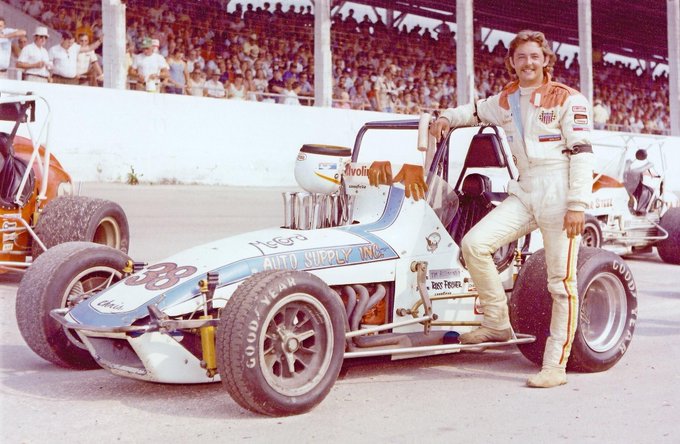
1978 Salem Speedway
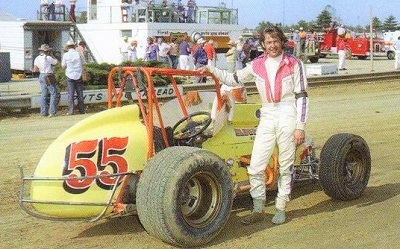
1978 Sprint Car Series
lawn. Richmond grew up in a well-to-do family, and was sometimes therefore treated differently by his classmates, so his parents enrolled him in Miami Military Academy in Miami, Florida. During his years in Miami, Tim and his mother moved to Florida and his father stayed in Ohio. While home in Ohio over a summer break, he met local drag racer Raymond Beadle through lifelong friend Fred Miller. Richmond excelled in sports; he set a conference record in high hurdles and his high school football career was stellar enough that the academy retired his sports jersey after his gridiron days were over. Miami Military Academy named him Athlete of the Year in 1970. Richmond's other interests included flying, and he earned his private pilot license at age 16. A friend of Richmond's
father co-owned a sprint car and Richmond joined the team as a crew member for Dave Shoemaker. In 1976, 21-year-old Richmond took the car onto Lakeville Speedway at Lakeville, Ohio for some practice laps. "Somebody put a stopwatch on me," Richmond said. "I was running laps faster than Dave had been. It was the first time I had ever driven a race car. Richmond raced in sprint cars in the United States Automobile Club's (USAC) national sprint car tour in 1978. Competing in 12 races, he was the series' Rookie of the Year. Richmond's father bought an Eagle Indy Car chassis and an Offenhauser engine for the 1979 race at Michigan International Speedway. Richmond qualified 21st fastest with a 175.768 mph lap, significantly slower than Bobby Unser's 203.879 mph pole position speed. After crashing during the first day of qualifying for
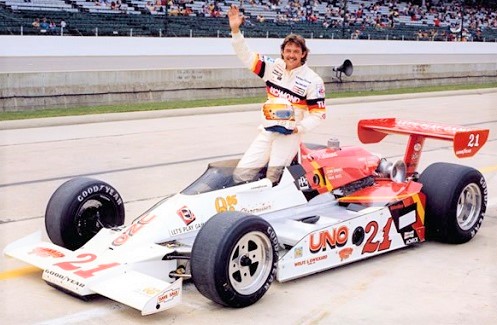
1980 Indy 500 Rookie of the Race
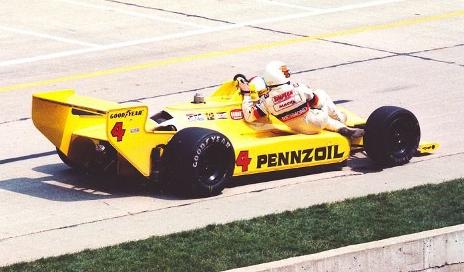
Hitching a ride back to pits... 1980
the 1980 Indianapolis 500, Richmond recovered and was able to qualify in the 19th starting position for the race. He worked his way up to the top 10 during the race, led a lap, and finished ninth as he ran out of fuel at the end of the race. To the delight of the crowd, winner Johnny Rutherford gave him a ride back to the pits. He was named the 1980 Indianapolis 500 Rookie of the Year. "I busted up a few Indy cars right after that," he said. "Milwaukee, Mid-Ohio. . . at Michigan I cut one in two. I was afraid my racing career would come to a halt. So when I got an offer to drive stock cars, I took it, and it turned out I liked driving them better. Pocono Raceway owner and founder Dr. Joseph Mattioli convinced Richmond
to make the change to stock car racing on the NASCAR circuit. Richmond made his first NASCAR start two months after winning the Indianapolis 500 Rookie of the Year award. He debuted at the Coca-Cola 500 Pocono on July 27, 1980, finishing 12th in a D. K. Ulrich-owned Chevrolet. In 1981 he had his first career Top 10 finish, taking sixth place at Talladega Super Speedway, soon followed by a seventh place finish at Texas World Speedway. In 1982 Richmond was hired to drive J.D. Stacy's #2 car. In his first race for the team, Richmond earned his first career top 5 finish when he placed fifth at Darlington Raceway. Returning to Pocono, he finished second, before winning his first race on the road course at Riverside, California the
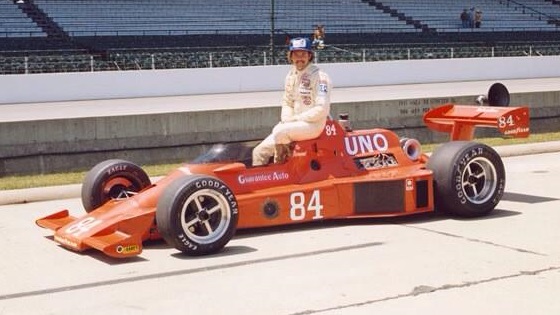
Last Indy start - 1981 Indy 500
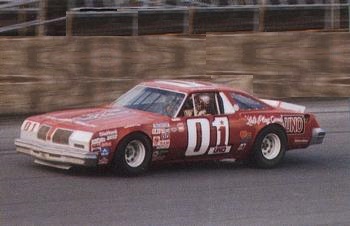
ARCA win Daytona 1981
following week. The tour returned to Riverside for the final race of the season where Richmond won his second race, sweeping both events at the track. For the season, Richmond had twelve top 10s, two wins, and one pole to finish 26th in points. In 1983, Richmond began racing for Raymond Beadle whom he had known before he started racing. He returned to the three-cornered Pocono racetrack, earning his first oval victory. In 1985, the final season that Richmond competed for Beadle, his best finish was a second place run at Bristol. He ended the season 11th in points with 13 Top 10's. Richmond joined Hendrick Motorsports in 1986, where he teamed up with veteran crew chief Harry Hyde. It took the team until the middle of the season to gel. Richmond had suffered a 64-race win-less streak that was finally broken at the Van Scoy Diamond Mine
500 at Pocono in June 1986. After two straight second place finishes at Charlotte and Riverside, Richmond started the Pocono event in third. That race saw a caution for rain with five laps left before the halfway point. NASCAR wanted the cars to get to the halfway point to make the race official, so the sanctioning body had the drivers slowly circle the track. It took the drivers 26 minutes to complete the laps, and the rain was so heavy that some drivers had to look out their side windows because they could not see out their windshields. Two hours later, the track had dried
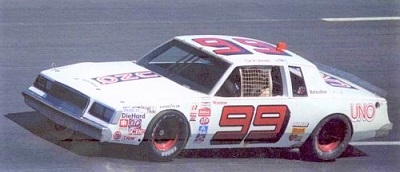
1981 Cup ride

1982 Cup series
and the race resumed with Richmond in third. Richmond took the lead with 30 laps to go, Dale Earnhardt made up three seconds on Richmond's five-second lead. With four laps to go, Buddy Arrington spun in a three-car accident. The remaining laps of the race where completed slowly under caution and Richmond took the checkered flag for the victory. He had led 97 laps, including the final 30, taking his first victory in a Rick Hendrick car. The tour returned to Pocono a month later, and Richmond battled for another victory in a fog-shortened event. In the final 8-lap sprint, Richmond competed in a three-car battle with
Geoff Bodine and Ricky Rudd. Richmond crossed the finish line beside Rudd, winning the race by 0.05 seconds. He notched four more victories that season, and over a span of twelve races, Richmond earned three second place finishes, and six wins. Here is an interview a reporter did with Tim Richmond. The National Motorsports Press Association named him Co-Driver of the Year with Earnhardt after Richmond accumulated 13 Top 5 finishes and 16 in the Top 10. He had a career-best third place finish in points after winning seven events in 1986, in what was his last full NASCAR season. Richmond fell ill the day after the 1986 NASCAR annual banquet during a promotional trip to Chicago. He was not well enough to

Cup ride 1983-1985
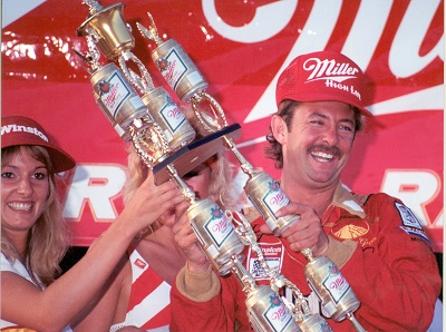
begin the 1987 NASCAR season despite lengthy hospitalization in Cleveland and further rest at home; when Richmond missed the Daytona 500, his condition was reported as double pneumonia. Media later reported that he had tested positive for acquired immune deficiency syndrome (AIDS). He returned to Pocono for the Miller High Life 500 during the middle of the year. Starting third, he led by the fifth lap and ultimately led 82 laps, including the final 46, to win the race by eight car-lengths over Bill Elliott. Richmond was emotional after the victory, saying, "I had tears in my eyes when I took the checkered flag. Then every time anyone congratulated me, I started bawling again". Richmond earned his last victory in the next race at Riverside, and made his final 1987 start at Michigan International Speedway's Champion Spark Plug 400 that August. He resigned from Hendrick Motorsports in
September 1987. Although Richmond attempted a comeback in 1988, NASCAR suspended him for testing positive for banned substances. NASCAR had developed its first drug-testing policy, which Richmond felt was designed with him in mind. He stopped taking his AIDS medication, AZT, six weeks earlier so it wouldn't be detected. He also asked his doctor to give him a drug test to make sure he was clean. He sealed the sample in a safe deposit box in Daytona Beach Shores. He knew when he was clean when he signed NASCAR's drug-testing consent form in the Daytona garage area, so he asked to take the test right then. Two days later, NASCAR announced Richmond was suspended indefinitely for testing positive
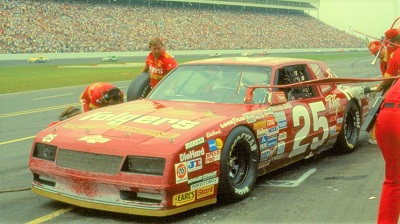
1986 Fire Crackers 400 win

1987 Comeback win - Pocono
for substances on its list of banned drugs. Richmond met with Les Richter, told him there was a mistake and demanded another test. Five days later, NASCAR announced Richmond's first test actually showed nothing more than over-the-counter cold medicine. The second test was clean. "We were under a certain amount of pressure to release some sort of information as soon as we reasonably could," says Williams, the former NASCAR spokesman, of the initial suspension. "Tim Richmond wasn't going to be there (for the race). He was suspended. There had to be a reason. "And a few hours later, we released that," Williams said. Dr. Forrest Tennant,
NASCAR's drug testing consultant, says no scientific mistakes were made in analyzing Richmond's drug test. France wouldn't discuss Richmond, saying through a spokesman that a court order prohibits it. Meanwhile, Richmond was front-page news and holed up in the Daytona Hilton with a personal manager. On the legal front, Richmond tried hiring F. Lee Bailey but settled on Barry Slotnick, who had defended New York subway gunman Berhard Goetz. Slotnick wanted $15,000 in advance. Richmond agreed to pay if he'd come to Daytona for a press conference. Hendrick offered his airplane and pilot to pick Slotnick up. Semas can't recall any NASCAR
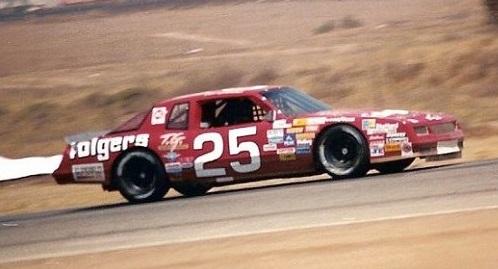
Last Cup win - Riverside 1987

drivers coming to see Richmond that week. But Indy Car champion A.J. Foyt did. So did drag racer Don "The Snake" Prudhomme, movie director Hal Needham, who hired Richmond for a bit part in "Stroker Ace," and Linda Vaughn. It was confirmed that Richmond could of filed a suit against NASCAR and have the race(s) canceled until such time the matter could be resolved, and if NASCAR had broken and laws or suspended Richmond illegally. Richmond released a public statement says that " It wasn't fair to the fans that his problems with NASCAR should be so much inconvenience for others. Fans had taken many
days off work, traveled great distances, bought tickets, paid for motels, and he just didn't feel it was fair to the Fans, so he would not file the suit, and let the race events proceed. He settled on hiring a plane to pull a banner over the Daytona 500 that read, "Fans, I Miss You. Tim Richmond." Richmond filed his lawsuit against NASCAR and Tennant in April 1988, seeking $20 million in punitive damages for defaming him through the drug test. NASCAR countered by demanding reams of information: Richmond's tax returns from 1980-87; the results of every test of his urine, blood or other bodily fluids since 1980; records of every visit to a doctor, psychologist or counselor since 1980; and his medical records from the Cleveland Clinic and his personal doctor in Florida. Next, NASCAR's lawyers went after his partying past, putting Richmond's friends under oath to find out more. "They wanted me to tell them that Tim did drugs," says Magovern, among those NASCAR deposed. "That's what they were looking for - to tear up Tim Richmond." Richmond's own deposition was taken in Charlotte in October. He gave his name, address, grew confused over where he had gone to grade school and the interview was postponed. Before leaving, he signed an autograph for the court reporter's son. He withdrew the suit three weeks after U.S. District Judge James B.
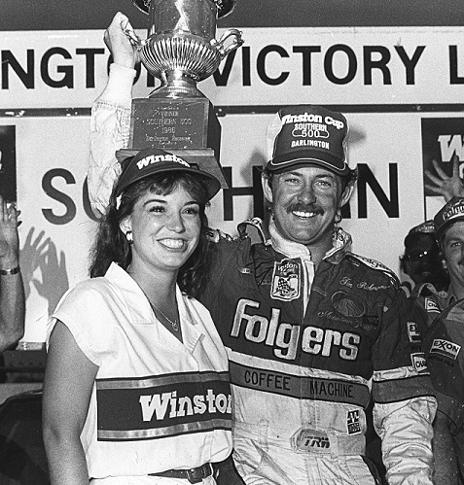
1986 Southern 500 win
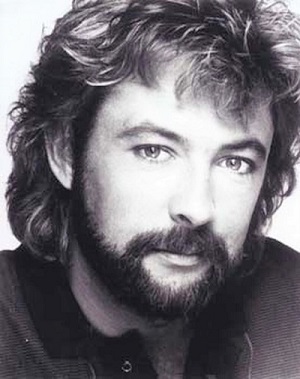
McMillan ordered his medical records be produced. Shortly before he died, Richmond talked with Hendrick about making his AIDS diagnosis public - a question he struggled with to the end. "He always said maybe I should take a positive step and try to warn people," Hendrick said, "but the country really wasn't ready for it. We all prayed there would be a cure. We chased everything we could find. And if he did come forward, it might have been even worse for him." His last months were filled with pain. "He suffered," Hendrick says. Richmond died as dawn broke over West Palm Beach on Aug. 13, 1989 about two years after his final NASCAR race. Ten days after his death, on August 23, the Richmond family held a press conference to reveal that Richmond died from complications from AIDS, which he acquired from an unknown woman. Punch later claimed that more than 90 drivers and personnel underwent HIV testing in the wake of Richmond's death. Each January since, Jimmie Johnson turns his new desk calendar to that date and copies the words, so he won't forget: "Tim died, 5:12 a.m." Many of Richmond's friends still struggle with thoughts of his question he struggled with to the end. "I think if he would have shared what he was going through, then people would have been supportive," says Ed Clark, Atlanta Speedway executive. Driver Kyle Petty
talked to Richmond by phone that last year, but he and his wife, Patti, wish they had done more. "We had regrets the year before he died," Patti Petty said. "I think everyone should feel a touch of regret. They dropped the ball. They really let him down. It goes back to NASCAR did not want that. It was like at some point, his name was white-washed from the list. "...We're as guilty as the next. But if you went to see him, made a friend out of this guy, is NASCAR going to let you through inspection? They wanted it swept under the carpet at that point." Kyle Petty says, "It all boils down to AIDS. I don't care what anybody tells you. Nobody knows how to handle AIDS - especially in a sport as backward-thinking on so many things as this sport is." In 1990, a few months after Richmond's death, Washington television station WJLA-TV and reporter Roberta Baskin reported that Dr. Forest Tennant, who was then the National Football League's drug adviser, "falsified drug tests" that ultimately helped shorten Richmond's NASCAR career. Baskin reported that sealed court documents and interviews showed Tennant and NASCAR used "allegedly false drug-test results in 1988 to bar Richmond from racing". Baskin also stated that NASCAR had targeted Richmond; requesting that Tennant establish a substance-abuse policy with Richmond in mind. A series of drug tests and falsely reported positive results shortly before the 1988 Daytona 500 kept Richmond from driving in what was to have been his last big race...", the report
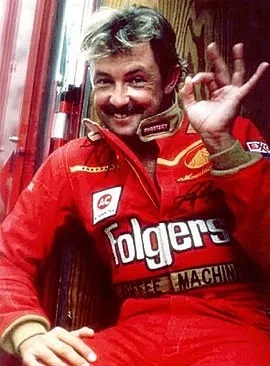
said. The New York Times published the findings. In 1998, NASCAR named Richmond one of its 50 greatest drivers of all time. He was inducted into the International Motorsports Hall of Fame in 2002. For his career Richmond ran in the Indy 500th twice, with a best finish of 9th. He ran in 10 Xfinity races, winning twice. He competed in 185 Cup events and won on 13 occasions. He won the 1986 Southern 500, and won five times on the road courses of Riverside or Watkins Glen. He also had four wins at Pocono, and won once at Daytona in the July 400 miler. Although we will never know, many drivers agree that Richmond had so much talent, he would of won several Cup championships, probably taking away a few that Jeff Gordon, and Dale Earnhardt Sr won. Some info from WikiPedia
